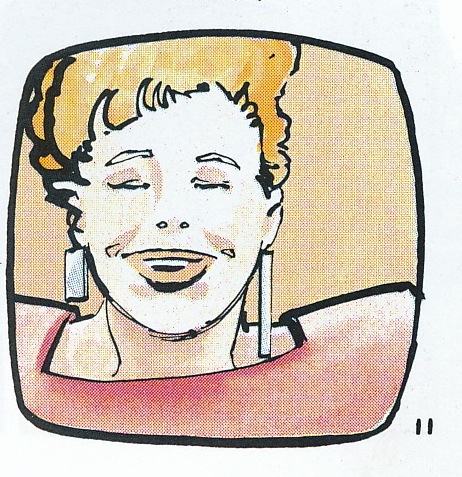 Breathing life into the only dynamic character in Batman: The Dark Knight Returns, Miller allows us to “hear” Bruce Wayne’s first-person narrative as an insightful running dialog between the person he once was and the person he has become. Wayne’s metastatic attitude toward the conditions of Gotham, a city he must both love and hate, keep him from focusing on the moral dilemma of sacrificing the few to save the many . Wayne’s metatextual comments assist the narrative as much as they reveal his provocative thoughts toward the criminals he seeks to annihilate. Wayne’s thinking is self-centered, and, of course, more appealing as the unconventional superhero. Gordon and Superman’s characters’ embody compassion and remain static throughout the novel. This is not a bad thing.
Breathing life into the only dynamic character in Batman: The Dark Knight Returns, Miller allows us to “hear” Bruce Wayne’s first-person narrative as an insightful running dialog between the person he once was and the person he has become. Wayne’s metastatic attitude toward the conditions of Gotham, a city he must both love and hate, keep him from focusing on the moral dilemma of sacrificing the few to save the many . Wayne’s metatextual comments assist the narrative as much as they reveal his provocative thoughts toward the criminals he seeks to annihilate. Wayne’s thinking is self-centered, and, of course, more appealing as the unconventional superhero. Gordon and Superman’s characters’ embody compassion and remain static throughout the novel. This is not a bad thing.
Dictated by the violence of his past and by the fierce rampage of helplessness he feels for the loss of a functional, loving world, Wayne is looked at as either a “crusader or [a] menace” (49). After the Joker kills over a hundred people in the audience of a night time talk show, Wayne expresses the futility of trying to take on criminals and the public together: “Every year they grow smaller. Every year they hate us more” (129).
Paradoxically, Commissioner Gordon has tremendous concern for the public safety, but he does not blame society as a whole. In fact, he worries repeatedly that after he retires his lack of influence and power will result in more chaos, violence and destruction to Gotham. Here we see the difference between Batman and Gordon. We readily recognize that authorial intention is aimed at keeping the city safe; the dichotomy of how Miller represents these two points of view on method and outcome complicate the characterization of Batman and foreshadow violence for the future.
Category: Week 2 – Dark Knight
A/symmetry
I’m not sure why, maybe it’s because I can’t wear dangly earrings anymore with my gauges, but the asymmetrical nature of newscaster Lola’s earrings caught me every time I saw a frame with her in it. At first I thought maybe there was just some sort of weird bar behind her head, but then as I saw more frames of her in different outfits with different earrings, I realized there had to be some point. This can’t merely be an homage to some sort of sweet 80’s earrings’ style.

This got me thinking about asymmetry and symmetry in the graphic novel in general. I thought it was interesting that Lola, the representation of the public’s general knowledge, was displayed as asymmetrical (imperfect, unbalanced, perhaps even flawed), while someone like Batman is illustrated as generally symmetrical, despite his internal warring halves. Even his symbol is symmetrical, further suggesting that Batman’s warring sides (Batman and Bruce Wayne) are not so much a flaw in his character, but the essence of what makes him good (in the moral sense). Batman is within himself a system of checks and balance, the Batman trying to ensure Gotham’s criminal are punished, and Bruce Wayne reeling the Batman in when necessary.

Lola, however, has no two sides, no full scope, merely reporting the misery of Gotham day after day. As a symbol of public knowledge, and therefore (maybe stretching this a bit…) the public itself, Lola’s asymmetry exposes the unchecked, unbalanced nature of the public, and perhaps the reason Gotham’s society cannot “take care” of itself. Gotham needs Batman, a hero whose moral compass requires no vetting when both of his sides continually keep him in check.
But that doesn’t mean we don’t have be wary of symmetry. I mean, look at Harvey Dent, the near epitome of symmetry now that he’s had plastic surgery. Though, I don’t think Harvey’s situation is quite the same as Batman’s, since Dent is not two warring persons so much as he is a person who has truly succumbed to his demons.